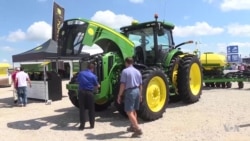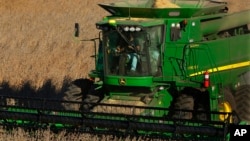The annual Farm Progress Show held every other year in Decatur, a town situated among the vast corn and soybean fields of central Illinois, is one of the largest farming exhibitions in the world, where manufacturers and suppliers show their latest and greatest products and equipment.
In some cases, it’s a starting point for farmers researching what big-ticket items are available to make their work in the fields more efficient, and easier.
But all Tolono, Illinois farmer Jeff Fisher can do at the John Deere exhibit at this year’s show… is look.
“A quarter of a million dollars list price for this planter,” he says, pointing to the large tractor behind him painted in the distinctive green and yellow colors of John Deere.“This is just a medium-size planter, and it isn’t a large planter by today’s standards.I’m interested in a planter, a notch below this planter, but the commodity prices aren’t high enough to be able to afford it.”
It’s been over five years since Fisher’s been able to afford new equipment, the last time he says he made a profit.
“The economics are tough on the farm,” he told VOA.“The profit margin isn’t there.We’re losing money where the cost of production of corn is higher than the price of corn on the Chicago Board of Trade and our local price.”
Stocks, costs up, commodity prices down
While U.S. stock indexes continue to see record-breaking gains and U.S. employment numbers are encouraging, U.S. farmers continue to struggle with high costs for fertilizer and seed at a time of low demand and low prices for their products.
The United States Department of Agriculture reports median net farm income in 2016 was the lowest since 2009, but projects a modest increase overall for 2017.However, the year-over-year hardship for many U.S. farmers has impacted more than just the agricultural industry.
“The Equipment Manufacturers Association released some pretty dismal numbers for farm equipment sales, and what that means to Caterpillar and Deere, that’s troublesome,” says Tamara Nelsen, senior director of commodities for the Illinois Farm Bureau, who outlined the interconnected relationship between manufacturing jobs and farmers like Fisher.
“If a farmer cannot afford to buy this, then those 25 workers that work to make it and the steelworkers who produce the steel, and all of the people involved in the parts they are not going to have jobs either.So farmers need to have good markets just like manufacturers need to have good markets.”
And it’s not just in the United States.The Association of Equipment Manufacturers or AEM also reported a 14 percent decrease in overall farm equipment exports for the first three quarters of 2016.Sales were down 44 percent from 2015 in Asia and 28 percent in South America.
“Our biggest concern is just being able to make it to next year to try again,” says farmer Mark Bremer, who grows corn and soybeans on his property in the southern Illinois town of Metropolis, where he also raises livestock.Like Fisher, he’s also getting by using old equipment to make ends meet.
“We would love to update, we’d love to purchase new technology and stuff, but that technology comes with a price – that technology didn’t come free,” he said.
Bremer isn’t sure when he’ll be able to afford new equipment, and is worried about the crop yield this year thanks to a lack of rainfall.
“Every year’s an experiment and that experiment is called farming,” he told VOA.“We’re not guaranteed the rain, we’re not guaranteed the price and we’re not guaranteed the yield either so it’s a continual challenge of making it.”
There’s also no guarantee next year will be better, but Fisher still has hope.
“We’re in the bottom of that roller coaster ride right now – I hope it doesn’t get worse,” he said.
A roller coaster ride that continues in just a few weeks as the next, and perhaps most important phase of his work as a farmer begins – harvesting this year’s corn and soybeans.









